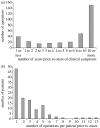Factors determining the potential for onward transmission of variant Creutzfeldt-Jakob disease via surgical instruments
- PMID: 17015298
- PMCID: PMC1885367
- DOI: 10.1098/rsif.2006.0142
Factors determining the potential for onward transmission of variant Creutzfeldt-Jakob disease via surgical instruments
Abstract
While the number of variant Creutzfeldt-Jakob disease (vCJD) cases continues to decline, concern has been raised that transmission could occur directly from one person to another through routes including the transfer of blood and shared use of surgical instruments. Here we firstly present data on the surgical procedures undertaken on vCJD patients prior to onset of clinical symptoms, which supports the hypothesis that cases via this route are possible. We then apply a mathematical framework to assess the potential for self-sustaining epidemics via surgical procedures. Data from hospital episode statistics on the rates of high- and medium-risk procedures in the UK were used to estimate model parameters, and sensitivity to other unknown parameters about surgically transmitted vCJD was assessed. Our results demonstrate that a key uncertainty determining the scale of an epidemic and whether it is self-sustaining is the number of times a single instrument is re-used, alongside the infectivity of contaminated instruments and the effectiveness of cleaning. A survey into the frequency of re-use of surgical instruments would help reduce these uncertainties.
Figures







Similar articles
-
Variant Creutzfeldt-Jakob disease and the potential for its accidental transmission following surgery with contaminated instruments: the risk of transmission in Australia.Folia Neuropathol. 2003;41(1):1-10. Folia Neuropathol. 2003. PMID: 12862389
-
Iatrogenic Creutzfeldt-Jakob disease via surgical instruments.J Clin Neurosci. 2013 Sep;20(9):1207-12. doi: 10.1016/j.jocn.2013.01.007. Epub 2013 Jul 27. J Clin Neurosci. 2013. PMID: 23896549 Review.
-
Lymphocyte contamination of laryngoscope blades--a possible vector for transmission of variant Creutzfeldt-Jakob disease.Anaesthesia. 2005 Jul;60(7):664-7. doi: 10.1111/j.1365-2044.2005.04221.x. Anaesthesia. 2005. PMID: 15960716
-
New thoughts on CJD, surgical instruments and disease transmission.Med Device Technol. 2006 Jan-Feb;17(1):7-8. Med Device Technol. 2006. PMID: 16483102
-
Methods to minimize the risks of Creutzfeldt-Jakob disease transmission by surgical procedures: where to set the standard?Clin Infect Dis. 2006 Sep 15;43(6):757-64. doi: 10.1086/507030. Epub 2006 Aug 11. Clin Infect Dis. 2006. PMID: 16912952 Review.
Cited by
-
Uncertainty in the tail of the variant Creutzfeldt-Jakob disease epidemic in the UK.PLoS One. 2010 Dec 23;5(12):e15626. doi: 10.1371/journal.pone.0015626. PLoS One. 2010. PMID: 21203419 Free PMC article.
-
Interventions to reduce the risk of surgically transmitted Creutzfeldt-Jakob disease: a cost-effective modelling review.Health Technol Assess. 2020 Feb;24(11):1-150. doi: 10.3310/hta24110. Health Technol Assess. 2020. PMID: 32122460 Free PMC article.
-
Prevalence in Britain of abnormal prion protein in human appendices before and after exposure to the cattle BSE epizootic.Acta Neuropathol. 2020 Jun;139(6):965-976. doi: 10.1007/s00401-020-02153-7. Epub 2020 Mar 30. Acta Neuropathol. 2020. PMID: 32232565 Free PMC article.
-
Is there the potential for an epidemic of variant Creutzfeldt-Jakob disease via blood transfusion in the UK?J R Soc Interface. 2007 Aug 22;4(15):675-84. doi: 10.1098/rsif.2007.0216. J R Soc Interface. 2007. PMID: 17287181 Free PMC article.
-
Nosocomial transmission of sporadic Creutzfeldt-Jakob disease: results from a risk-based assessment of surgical interventions.J Neurol Neurosurg Psychiatry. 2011 Feb;82(2):204-12. doi: 10.1136/jnnp.2009.188425. Epub 2010 Jun 14. J Neurol Neurosurg Psychiatry. 2011. PMID: 20547628 Free PMC article.
References
-
- Anderson R.M, May R.M. Oxford University Press; Oxford, UK: 1991. Infectious diseases of humans.
-
- Bishop M.T, et al. Predicting susceptibility and incubation time of human-to-human transmission of vCJD. Lancet Neurol. 2006;5:393–398. doi:10.1016/S1474-4422(06)70413-6 - DOI - PubMed
-
- Bruce M.E, et al. Transmissions to mice indicate that ‘new variant’ CJD is caused by the BSE agent. Nature. 1997;389:498–501. doi:10.1038/39057 - DOI - PubMed
-
- Clarke P, Ghani A.C. Projections of the future course of the primary vCJD epidemic in the UK: inclusion of subclinical infection and the possibility of wider genetic susceptibility. J. R. Soc. Interface. 2005;2:9–31. doi:10.1098/rsif.2004.0017 - DOI - PMC - PubMed
Publication types
MeSH terms
LinkOut - more resources
Full Text Sources
Medical

